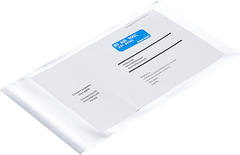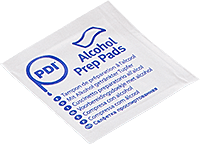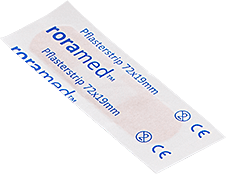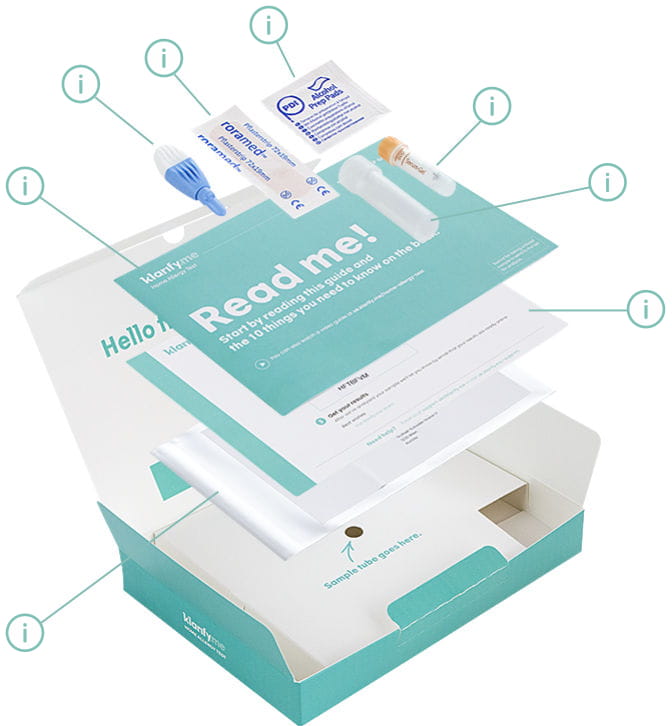Hay fever test
If you have hay fever the pollen season can feel like no fun at all. Hay fever is also known as a pollen allergy or even seasonal allergic rhinitis. Seasonal because it’s connected to the flowering period of specific plants. Hay fever is a common allergic reaction.
Hay fever occurs in some people when pollen comes into contact with your mouth, eyes, nose or throat. Trees, grasses and weeds all release pollen into the air from early spring, through the summer and even into autumn. That’s a long time to be sneezing, have a runny nose and itchy, watery eyes!
You may be allergic to only one or to several types of pollen. Hay fever symptoms can start at any time during the pollen season depending on which pollen you’re reacting to. Knowing exactly which pollen or pollens you're allergic to can help you make plans and get through the season. But how do you know which pollen affects you?
About the hay fever test
The Home Allergy Test is a first step to finding out if hay fever might be causing your symptoms. It's easy to use and backed by science. Using sophisticated technology, the Home Allergy Test analyses your body's reaction to 294 different allergens. Hay fever allergy testing with the Home Allergy Test includes testing for 59 different grass, trees and weed pollen allergens and components. That allows for comprehensive precision testing right down to individual proteins in an allergen source.
The Home Allergy Test kit contains everything you need to collect a small blood sample from your fingertip. There’s a step-by-step guide to help you and you can also watch our how-to video. Give yourself about 30 minutes to collect your blood sample for the hay fever test.
Then all you need to do is post your blood sample to our partner lab for analysis. A prepaid return envelope is included in the test kit. We ask you to post the sample within 24 hours after collecting it to make sure it’s stable and suitable for testing.
Before you send your blood sample to the lab, you’ll need to activate your test online. This creates your unique account. The test kit includes all the details you need to do this.
Your hay fever test results will be available in your online account within two weeks. The hay fever test results show the level of specific Immunoglobulin E (IgE) antibodies in your blood and can indicate if you’re sensitised to the different allergens tested, including grass pollen and pollen from trees and weeds.
Order your Home Allergy Test today and take the first step towards finding out if you might have hay fever.
Many allergens, one test
The Home Allergy Test tests and analyses your body’s reaction to 294 different allergens including:- Pollen 59
- Pets 25
- Insect stings 10
- Moulds & yeasts 13
- Foods 154
- Other 14
Symptoms for hay fever
Hay fever symptoms can make you feel lousy. Hay fever symptoms are a form of allergic rhinitis. Allergic rhinitis causes the inside of your nose to become irritated and inflamed because your body is reacting to airborne allergens.
If you have hay fever and the fine particles of pollen come into contact with your mouth, eyes or nose, your immune system mistakes them for threatening intruders. It sets off a chain of allergic reactions as a mode of defence. Cells in your airways release histamine, which makes the lining of your nose swell. And extra mucus is produced to try to flush out the pollen.
You could start with a hay fever test.
9 hay fever symptoms checklist
- Stuffy nose (nasal congestion)
- Runny nose, usually with clear fluid
- Sneezing
- Itchy nose
- Itchy, red, watery eyes
- Post-nasal drip (the feeling of mucus moving down the back of your throat)
- Cough
- Tight chest or wheezing
- Sinus inflammation/pain
Hay fever can involve any combination of the symptoms from the checklist, but a blocked nose, runny nose and sneezing are among the most common.
How do you know if you have hay fever or just a cold?
It can sometimes be difficult to know if you're experiencing symptoms of hay fever caused by an allergic reaction to pollen or whether you've got a cold. It’s easy to assume your sneezing and runny nose are caused by yet another cold. But if you suspect your symptoms might not be a cold after all, there are some typical signs to look out for.
The fundamental difference is a cold is caused by an infection with a virus and hay fever is caused by an allergic reaction. With hay fever, there’s no infectious germ. Your body is reacting to allergens in the air.
There are two tell-tale signs to look for: How quickly the symptoms develop and how long they last.
A cold usually develops over a few days. But hay fever symptoms can appear quite suddenly. Symptoms of a cold typically last about a week. Hay fever symptoms go on for as long as you're exposed to the pollen. Symptoms of hay fever can occur for many weeks or even months. And you don't usually have a raised temperature with hay fever but it is common when you have a cold.
The Home Allergy Test can help you find out if your symptoms might be caused by hay fever. This hay fever allergy test can pinpoint which pollen types could be the culprits.
What is pollen anyway?
To understand hay fever, we need to take a look at pollen.
Pollen is released by certain plants, trees, grasses and weeds as part of their reproductive cycles. The grains are microscopic, just a small amount of pollen powder can contain thousands of grains.
Weather conditions can affect pollen levels. Large quantities of some types of pollen can be carried in the air far and wide as it’s so small and light. Airborne pollen is the sort of pollen that is more likely to trigger symptoms of hay fever.
Flowering plants, such as roses and lilies don’t release pollen into the air. These types of plants have waxy pollen. Waxy pollen travels from plant to plant sticking to bees and other insects. It doesn’t usually trigger allergic reactions.
Pollen count and pollen calendars
Pollen levels affect everyone differently. Your allergy symptoms may be worse at a certain time of the day. The weather also makes a difference. For example, more pollen is carried through the air on hot, dry and windy days. And less so on rainy days.
Using a pollen calendar or pollen and weather forecast is really useful when you have hay fever. It means you can find out when pollen is likely to be present where you are. And what the pollen count levels are. Then you can adjust your daily routine: like when you spend time outdoors, for example.
The impact of climate change on hay fever symptoms
Climate change is modifying the time and length of the pollen season. The timing of tree and grass pollen seasons depends on when spring temperatures signal the end of winter. This can affect the length of the pollen season in some plant species. And it’s been discovered that plants produce a higher quantity of pollen under these changed conditions. Which can have an impact on your hay fever symptoms.
All you need is in the box
Prepaid return envelope
Use this to send your sample to the lab
Welcome card
Includes your unique activation code and instructions how to use it
Step-by-step guide
Start by reading this guide and the 10 things you need to know on the back
Lancing device
Sterile device to prick your fingertip to obtain a small blood sample
Plaster
To put on your fingertip after collecting the blood sample
Alcohol wipes
Use to sanitise your finger
Transport tube
Filled sample tube goes into the transport tube. Both tubes are then sealed into the prepaid return envelope for posting to the lab
Sample tube
Tube to collect about 6 drops of blood










Why you should get tested for hay fever
Getting a hay fever test for seasonal allergic rhinitis means you'll be able to find out which pollens might be triggering your symptoms and rule others out. When you know what's causing your hay fever symptoms, you're in a better position to know how to manage them. A hay fever test can help you find out.
Uncontrolled symptoms of allergic rhinitis can cause more than just a nuisance. For some people, hay fever can have quite an impact on everyday life, work or school performance, social activities and more.
Symptoms of hay fever can disturb your sleep, making you feel tired and drained during the day. During the pollen season, school children and college students may find it difficult to pay attention and learn when their symptoms are bothersome. Exams are often timetabled for the spring and early summer months. Seasonal allergic rhinitis symptoms can affect the student's concentration during exams. And severe symptoms of hay fever may mean students even have to be absent from school or college.
Hay fever can affect your working life too. Your concentration may be affected if you're troubled with seasonal allergic rhinitis. And that can affect your productivity and work performance. If your hay fever symptoms are severe, you may need to take time off work.
Allergic rhinitis can also affect your emotional and mental health. Severe allergic rhinitis symptoms may contribute to depression and anxiety in some people.
The practical advantages of being tested for allergies
The Home Allergy Test is an allergy blood test, which detects Immunoglobulin E (IgE) in your body. IgE is an antibody produced by the immune system to protect us from outside intruders such as parasites. IgE plays a vital role in allergic reactions to many substances.
We believe there are practical advantages to being tested for allergies. Identifying specific IgE antibodies in your blood can give an indication of your sensitisation to potential allergy triggers, including pollen. It doesn’t mean you’re necessarily allergic to them though. Results of an allergy test for sensitisation can be a first step to finding out if you have allergies.
In order to make a diagnosis of hay fever, your doctor will consider any allergy test results along with your medical history. With an accurate diagnosis, you'll be able to get access to the most suitable treatments for your hay fever and any other allergies.
Hay fever: a closer look
Hay fever is a common allergic reaction to pollen from trees, grasses and weeds. It can affect people all around the world, children as well as adults. Allergies tend to run in families. If one parent is affected the child statistically has a 30-50% chance of developing allergies too. If both parents have allergies, the risk increases to 60-80%. However, this isn't a blanket rule.
Allergic rhinitis is caused by an overreaction of the immune system. The job of our immune system is to protect us from infectious bacteria, viruses, fungi and parasites. But if you have hay fever, pollen is perceived as a threat and your body takes defensive action to try and get rid of it, and fast!
You probably won't have an allergic reaction to pollen the first time you come into contact with it. There's a process to how allergy develops. The process is called sensitisation. To understand sensitisation, we need to take a closer look at the nitty-gritty of allergy.
What is sensitisation?
Sensitisation isn't the same as allergy. It's the first step in developing allergies. First of all, your immune system has to register a substance as something that may be harmful. When a substance that is usually harmless triggers an allergic response, the substance is known as an allergen. Your immune system memorises the structure of the allergen so it can produce specific IgE antibodies in defence.
You're sensitised when you have specific IgE antibodies in your blood. Once you've been sensitised, your body will produce IgE every time you encounter that substance again.
When you next come into contact with that allergen, the specifically built IgE antibodies recognise it and the chain of allergic reaction begins. Different chemicals are released, including histamine. Histamine is part of an inflammatory response. Various fluids and white blood cells surge to where the allergen has entered your body. In the case of hay fever, that’s likely to be your eyes, nose and throat. This causes swelling and other typical symptoms of allergy. And your body produces more mucus to flush the allergen out.
Sensitisation doesn't always lead to symptoms, but symptoms don't develop without sensitisation. You can be sensitised without having an allergic reaction, but you can't be allergic without being sensitised first. Detecting sensitisation can be a useful tool to identify potential allergy triggers. Being diagnosed with an allergy means you're both sensitised and experience an allergic reaction.
What’s pollen food syndrome or oral allergy syndrome (OAS)?
Does your mouth or throat itch when you eat certain foods? It could be pollen food syndrome, also called oral allergy syndrome (OAS). Pollen food syndrome is generally considered to be a mild form of food allergy. If you have hay fever then you might experience this unexpected cross-reaction between pollen and certain fruits, vegetables and nuts, especially when eaten raw.
The reaction occurs because the proteins in some fruit, vegetables and nuts have a similar structure to the proteins in pollen. The immune system overreacts, resulting in a contact allergic reaction in or around the mouth. This mix-up between different protein structures in pollen food syndrome is known as cross-reactivity.
What are the symptoms of pollen food syndrome?
The most common symptoms of pollen food syndrome are itching or swelling of the mouth, lips, tongue and throat. You may experience these symptoms soon after eating a particular fruit, vegetable, nut or spice. Or it may take several hours after eating it for the cross-reaction to occur. Symptoms of pollen food syndrome are usually mild and resolve soon after the person stops eating the offending food.
Itching in your mouth or throat from, for example, peanut, soybean, almonds and hazelnuts can also be an early warning sign of a more serious food allergy that could cause anaphylaxis. It’s important to see a doctor if you’re having these symptoms.
Which types of pollen can be a cause of oral allergy syndrome?
You may experience a cross-reaction to different foods depending on which type of pollen you are affected by.
In the UK, birch pollen allergy is the most common cause of pollen food syndrome. Birch pollen proteins can cross-react with many food types, including apples, apricots, cherries, peaches, pears, plums, kiwi, carrot, celery, parsley, peanut, soybean, almonds or hazelnuts.
If you’re allergic to Timothy and orchard grass pollen, you may experience a cross-reaction when you eat, for example, peach, watermelon, orange, tomato and white potato.
Mugwort pollen cross-reacts with many different vegetables and spices, such as fennel and black pepper.
4 simple ideas to help keep pollen out of your home
If you suspect hay fever might be causing your symptoms of allergy, there are a few things you can try to reduce the amount of pollen getting into your home:
- Keep doors and windows closed if you can.
- Air your rooms when the pollen count is low.
- Wash your hair before you go to bed and leave your clothes in a different room from the one you sleep in.
- Don’t dry your washing outside. Use a tumble dryer or hang it to dry inside your home instead.
Start your journey right here
The Home Allergy Test detects your body’s reactions to 294 allergen extracts and allergen components. Take a first step to finding out if hay fever might be causing your symptoms. Order your Home Allergy Test today.
Others say
"I got the results and I have to say, I am very impressed.
I have only ever noticed suffering from sensitivity to cats, dust and a bit on grass before moving house at the end of Feb and I’ve always been able to control these reactions with off the shelf antihistamine, the test confirmed sensitivity to all of these.
Since moving I have suffered badly from a far more severe reaction to something unknown, I had assumed it was pollen from the symptoms as I am now surrounded by trees and flowering plants and there is a park behind the house, so plenty of grass too. My hope when taking the test was to find out if this new issue was a general sensitivity or if there was something specific in my new environment which was causing it. I am delighted that the test came back with such a strong positive on Ash tree pollen along with a moderate on Olive (which as I’m reading are in some way connected) while showing no sensitivity to other tree pollen types at all.
Having checked the pollen season for Ash trees it seems to coincide really well with when I had my symptoms, I.e. through March and April I was really bad but its clearing up now in May to the point that its negligible now. Looking around outside I think I’ve spotted the culprit at the back of my garden right next to where I’ve been sitting when outside!
I was sceptical about spending the money on this but at the time my symptoms were so harsh I think I’d have tried almost anything! I’m so glad that I did this now." - Rob S.
"Great product! For a while now, I have suspected that my son might have an allergy. I was leaning towards tree or grass pollen, but he didn’t really seem to be consistently bothered when being outside. I bought the home allergy test to understand what he was sensitised to. The guide that comes with the product, made it a simple exercise to complete the test. Drawing the blood took about 20 seconds, and there is really little hassle at all.
The report came back within a couple of weeks and showed high sensitisation to house dust mite. Didn’t think of that beforehand. So now we know where to focus and we have had dialogue with our doctor for next steps and proper treatment." - Morten S.

